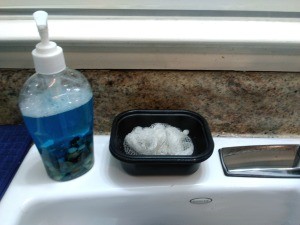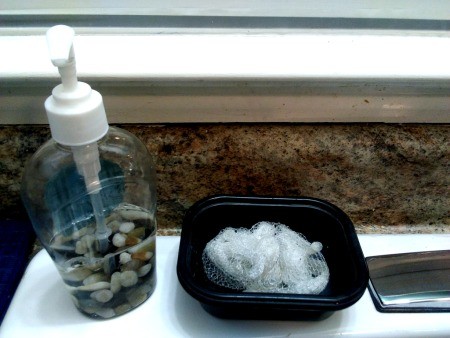
 A lot of us find the better dish detergents so thick and concentrated, we choose to dilute them a bit (or a lot). We save money and the product is easier to use. I no longer use tap water to dilute my dish detergent. While it works quite well, I've found something I like better, hydrogen peroxide.
A lot of us find the better dish detergents so thick and concentrated, we choose to dilute them a bit (or a lot). We save money and the product is easier to use. I no longer use tap water to dilute my dish detergent. While it works quite well, I've found something I like better, hydrogen peroxide.
I bought a bottle of hand soap from Dollar Tree just to get the pump bottle. When empty, I put several small decorative rocks in it to give it weight to help keep it from tipping over.
I did find that most liquid dish detergents are so thick, it's a little hard to dispense them from a pump bottle. That was my main reason for diluting it. And of course, I save money.
I found peroxide makes an extender that is better than water. My formula is simple: 2 parts detergent to 1 part peroxide. Not only does the peroxide add additional antiseptic properties to the detergent, the sudsing is about doubled. Though there are more suds than you would ever want, they are easily rinsed away.
So, cleaner dishes for less money. I rarely fill my dish cloth with detergent more than once when doing dishes. The suds just keep coming and the dishes are antiseptically cleaner.
And don't be surprised; the peroxide will turn your blue detergent to clear in a day or two.

Add your voice! Click below to comment. ThriftyFun is powered by your wisdom!
Peroxide rapidly breaks down & does not retain its antiseptic properties once exposed to light. That is why it is sold in opaque brown bottles. Many cleaning solutions are effective for only a limited time after mixing &/or exposing to light, heat, bacteria. Some examples are bleach solutions (sodium hypochlorite) & many disinfectant commercial cleaning solutions. They must be mixed fresh each time you use them. If a product not meant for dilution is diluted into a solution then any antibacterial properties are lost. (ex: peroxide & isopropyl alcohol added to cleaning mixes). Such chemicals are only antibacterial in their original concentrations & only when used properly.
I agree with you for the most part as I have mentioned in other posts that peroxide loses its antiseptic properties when exposed to light, heat and contaminates. Your comment would best be answered by one degreed in chemistry and I am not.
I will say this: the degradation of peroxide when exposed to light is not instantaneous and the speed and degree of degradation would depend on several factors.
To test this, though not advised, one could pour an ounce of 10 volume (3%) peroxide into a small clean container, let it sit for 24 hours in a room with normal lighting. Then place the tip of the fore finger into the peroxide and hold it there for one minute.
One would experience a burning, stinging sensation along with (temporary) whitening of the skin. This is evidence the peroxide has retained most of its antiseptic properties over the 24 hour period.
I disagree that diluting antiseptic solutions causes them to lose (all) their effectiveness, per se. Again, several factors are involved. While 3% peroxide is sold primarily as a debriding agent, in most cases it is too strong to use for this purpose without diluting. This is why my periodontist advised me to use peroxide as an antibacterial, antiseptic debriding agent when diluted with two parts water.
And too, if peroxide loses its effectiveness when mixed with other chemicals, then I am wasting my money by buying Colgate tooth paste containing baking soda and peroxide with a host of other cleaning chemicals. The truth is, certain chemicals added to peroxide will cause it to degrade while other chemicals will not. Ammonia added to peroxide will act as a catalyst while certain other chemicals will act as a preservative.
It would take an in lab analysis to determine the degree of antiseptic property degradation over the week's time it takes me to use the detergent/peroxide mixture. I'm not ready for that expense. Just as the peroxide in toothpaste should remain effective for quite some time, so could the peroxide in my detergent. How long it could remain effective would depend on what chemicals it was mixed with. You have caused me to think, though. It would be best if I put my solution is an opaque pump bottle.
Actually, it takes about three days for the added peroxide to turn the detergent (Walmart's Great Value equivalent to Dawn) from deep blue to completely clear. This is proof that the peroxide has retained some of its bleaching (and I would assume some of its antiseptic properties) for at least that three day period.
And as to whether the addition of peroxide 'extends' the detergent, there's no doubt. I'm using less per pump simply because it's diluted. And as for increased sudsing even when diluted, all I have to say is, If you don't believe it, try it for yourself.
Add your voice! Click below to comment. ThriftyFun is powered by your wisdom!